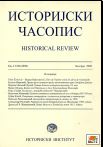Потрошни материјали у османском рударству и металургији
Auxiliary Materials Used in Mining and Metallurgy of the Ottoman Empire
Author(s): Srđan KatićSubject(s): History
Published by: Istorijski institut, Beograd
Keywords: Ottoman Empire; mining; metallurgy; firewood; charcoal
Summary/Abstract: Auxiliary materials such as wood, charcoal and fireproof clay were of the utmost importance in the mining and metallurgy industry until the XIXth century. The quality of the ore as well as the abundance of the nearby forests had the crucial influence on the decision concerning the opening of the new mining sites in the Ottoman period. The only exception to this was made by the exceedingly rich ore deposits such as Keban and Ergani mines in the South Eastern Anatolia, where charcoal and wood were being delivered from the highly remote areas. The saltpeter and sulphur mines, having provided components of gunpowder, set a precedent, too. The richness of the ore deposits was primordial, due to their strategic importance for the Ottoman army, while the issue of production profitability was only of the secondary significance. Charcoal made from willow and hazel tree was used as component of gunpowder in the Ottoman Empire, while charcoal made from oak, beech or other hardwood was used in smelteries and founderies. In the proximity of every mining site, the village settlments were established, called the workers’ hâs (işçi hâs). Their inhabitants were generally engaged in production and delivery of charcoal and wood materials, due to which, they enjoyed significant tax exemptions. Thus did the number of villages depend upon the specific ore, that is, the quantity of charcoal used in the melting process. For instance, the copper mine of Majdanpek in the Smederevo sancak supplied only few villages due to the small quantity of charcoal used in the copper melting process: the mine of Kučajna, that provided lead, silver and gold as well as the fourty-eight villages, while the iron mine of Bah, where cannon balls were being cast, was supplied by the workers’ hâs consisted of as many as ninety-two villages. The structure of the mining administration manifested importance wood and charcoal had for mining and smelter production. Most commonly, the total number of the şafar who were supervising mines and smelteries production, corresponded to that of the şafar in charge of charcoal and wood delivery. The rare type of clay possessing fireproof qualities has also been classified in auxiliary materials used in metallurgy. It was used in production of cannon and cannon balls molds, as well as for building stoves for the factories manufacturing cannons and fieldpieces. That type of clay deposits was very scarse; consequently, some of the factories for manufacturing cannons and fieldpieces had bigger problem supplying with clay, than stocking up on metal supplies. Thus was, from the end of the 1560’s, the clay being sent from the excavation site situated in Belgrade surroundings to the factory for manufacturing cannons and fieldpieces in Budim, due to the exhaustion of the ore deposit. Only a century later, the factory for manufacturing cannons and fieldpieces located in Belgrade was being supplied with clay from Kâğid-hâne, Istanbu
Journal: Историјски часопис
- Issue Year: 2009
- Issue No: 58
- Page Range: 197-207
- Page Count: 11
- Language: Serbian

